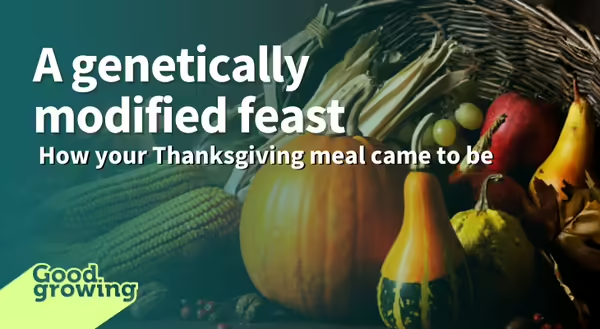
Silky smooth potatoes, snappy beans, bright sweet potatoes, deep green collards, and turkeys the size of Volkswagens. It is that time of year when someone in your family cooks like a chef on a reality TV show. Once the yelling ends and smoke alarms are silenced, standing back from the table reveals a bountiful spread of food celebrating a fruitful year as did that celebration of the first Thanksgiving feast in October of 1621.
Artificial Selection
The first genetic alteration
The food on our tables is not simply plucked from nature. Most of what we eat has gone through hundreds if not thousands of years of selection. The Dawn of Agriculture, considered to have begun about 10,000 years ago, gave rise to the artificial selection of plant species. Early humans picked crops they liked to eat, favoring the best performers by selecting those for the next growing season and tossing out plants that did poorly.
The curious case of wild cabbage
Artificial selection over time enhanced traits such as olives with higher oil content or larger and sweeter tomatoes. One of the best examples of artificial selection is wild cabbage (Brassica oleracea) which popped up as one of our first crops 10,000 years ago. Wild cabbage can be found several times in ancient texts, meaning we have been munching on this plant for a long time.
Early farmers began the process of artificial selection for wild cabbage by picking certain traits of this plant and cultivating plants with those traits. Likely an ancient farmer noted that one wild cabbage had a tasty flowerhead, and one particular plant grew larger flowerheads than its siblings. Fast-forward thousands of years, we now have broccoli. Perhaps another farmer noted the tight, dense leaf buds at the base of a wild cabbage. Time travel to the present and you have cabbage. Not only is wild cabbage responsible for the development of broccoli and cabbage but also cauliflower, Brussels sprouts, kale, collard greens, savory, kohlrabi, and more. Essentially, what we have today are the exaggerated versions of ancient wild cabbage traits.
Plants within the wild cabbage group are still able to interbreed which has led to all types of novelty crops such as broccolini, broccoflower, and Brusselkale. In effect, we did to wild cabbage what we did to wolves. Picture in your head a wolf and then next to it a fluffy labradoodle. These are genetic modifications using traditional breeding methods.
Bioengineered foods (BE)
Grab your artificially selected popcorn. Things are about to get heated!
(BE popcorn has not been developed, yet.)
We don’t need more to argue about at the Thanksgiving table, but if necessary to divert away from politics consider an argument of science such as bioengineered foods (BE). Like artificial selection, bioengineering is a manipulation of genes, but in this case, scientists are using laboratory-based technologies. Early BE techniques were like using a wrecking ball on DNA, they were inaccurate and just about as random as traditional breeding. Current technology like CRISPR is more akin to a scalpel for gene editing. And if you're wondering what CRISPR stands for, here it is - Clustered Regularly Interspaced Short Palindromic Repeats. Obvious, right?
This higher level of BE technology has allowed humans to not only cross desirable traits within a species but to cross to entirely different species. It is how we have Bt-corn. Bt (Bacillus thuringiensis) is a bacterium that is toxic to caterpillars. Scientists were able to insert those Bt genes into field corn, lessening the damage of pest caterpillars like corn earworm. Think back to our wolf-to-dog example using traditional breeding from before, except this time we are using CRISPR to edit our labradoodle’s DNA to insert the firefly gene for bioluminescence so our dogs will glow in the dark.
BE crops are regulated by the FDA. Here is a list of those crops approved for growing in the United States.
Are BE crops the answer to our world's food problems? They are not the only solution and certainly not without their own set of problems. For instance, crops that have been bioengineered to include the bacterium Bt are showing an increase in insect damage as pests develop resistance to the toxic effects of Bt. For civilization to move into the next age of agriculture our diverse world will require a multitude of options for growing food and continual work to tackle unforeseen problems.
As we gather around the table this Thanksgiving, realize the food in front of you has come from generations of artificial selection and in some cases recent decades of BE work in a lab. Thank you to those farmers and scientists, both ancient and modern, who have worked to keep our tables and bellies full. Now I think I’m going to investigate patenting my glow-in-the-dark Labradoodle idea. Happy Thanksgiving!
Good Growing Tip of the Week: Nervous about the scientific use of bioengineering? This is a question of ethics. Science tells us what we can do, and ethics asks if we should. Both are critical to the development of future agricultural technologies. Continue the conversation and stay open to learning more about both sides of the debate.
Sign up for our emails! Want to get notified when new Good Growing posts are available? SIGN ME UP
Give us feedback! How helpful was this information (click one): Very helpful | Somewhat helpful | Not very helpful
MEET THE AUTHOR
Chris Enroth is a horticulture educator with University of Illinois Extension, serving Henderson, McDonough, Knox, and Warren counties since 2012. Chris provides horticulture programming with an emphasis on the home gardener, landscape maintenance personnel, and commercial landscapers. Additional responsibilities include coordinating local county Master Gardener and Master Naturalist volunteers - providing their training, continuing education, advanced training, seasonal events, and organizing community outreach programs for horticulture and conservation assistance/education. In his spare time, Chris enjoys the outdoors, lounging in the garden among the flowers (weeds to most).